2015 MERCEDES-BENZ SLS AMG GT COUPE weight
[x] Cancel search: weightPage 264 of 290
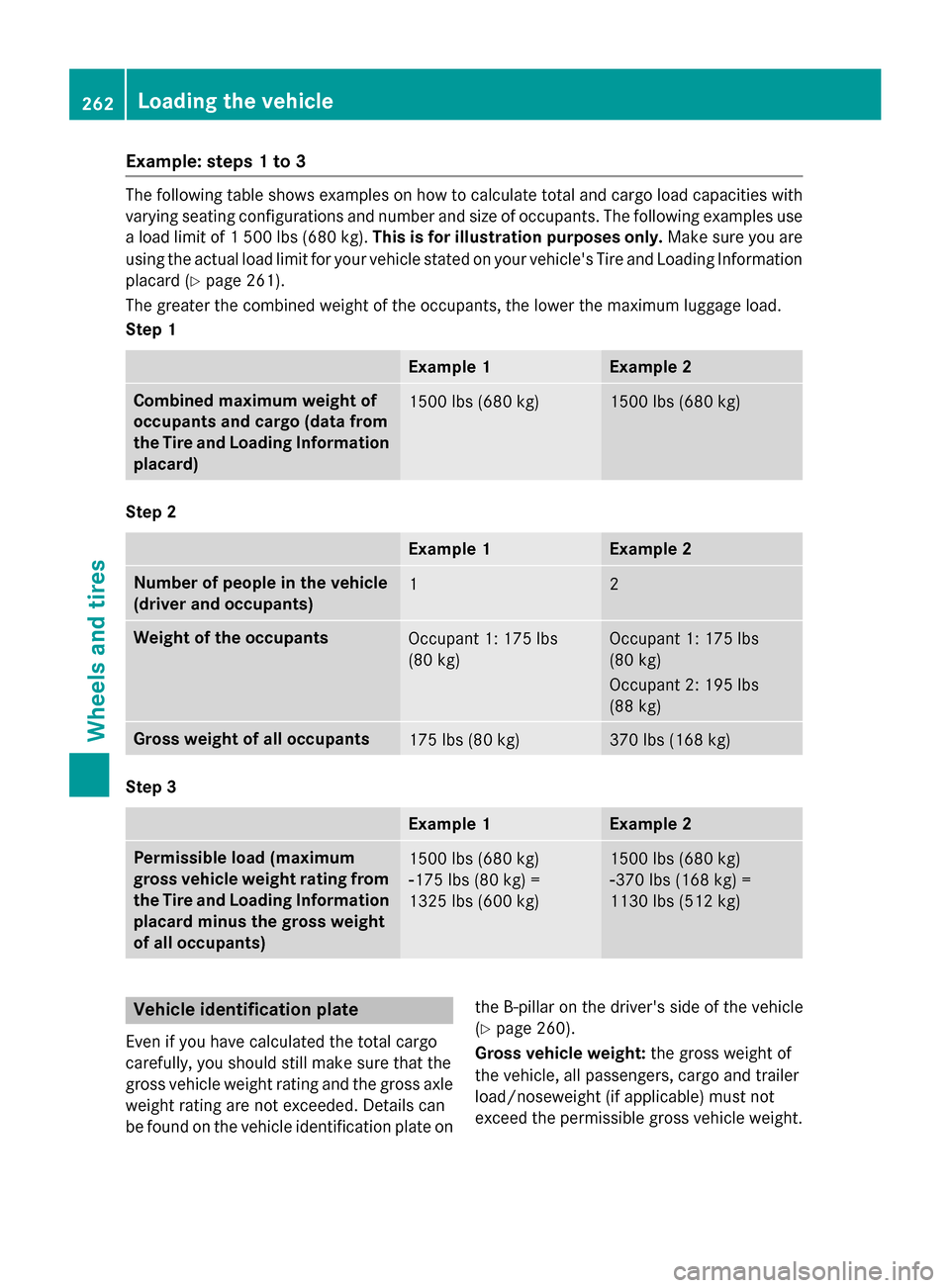
Example: steps
1to3The followin
gtable show sexamples on how to calculate total and cargo load capacities with
varying seating configurations and number and siz eofoccupants. The followin gexamples use
al oad limit of 1500lbs (68 0kg). This is for illustration purposes only. Makesure you are
usin gthe actual load limit for your vehicle state donyour vehicle's Tire and Loading Information
placar d(Ypage 261).
The greate rthe combined weight of th eoccupants, th elower th emaximum luggage load.
Step 1 Example 1 Example 2
Combined maximum weight of
occupant
sand cargo (data from
th eT irea nd Loading Information
placard) 1500 lbs (68
0kg) 1500 lbs (68
0kg) Step 2
Example 1 Example 2
Number of people in th
evehicle
(driver and occupants) 1 2
Weigh
toftheoccupants Occupan
t1:175lbs
(80 kg) Occupan
t1:175lbs
(80 kg)
Occupan t2:195lbs
(88 kg) Gross weight of all occupants
17
5lbs (80 kg) 37
0lbs (16 8kg) Step 3
Example 1 Example 2
Permissible load (maximum
gross vehicle weight ratin
gfrom
th eT irea nd Loading Information
placar dminus th egross weight
of all occupants) 1500 lbs (68
0kg)
00F817 5lbs (80 kg) =
1325 lbs (60 0kg) 1500 lbs (68
0kg)
00F837 0lbs (16 8kg) =
1130 lbs (51 2kg) Vehicle identification plate
Even if you have calculate dthe total cargo
carefully, you shoul dstill mak esure that the
gross vehicle weight rating and th egross axle
weight rating are no texceeded .Detail sc an
be foun donthevehicle identification plat eonth
eB -pillar on th edriver' sside of th evehicle
(Y page 260).
Gross vehicle weight: theg ross weight of
th ev ehicle ,all passengers ,cargo and trailer
load/noseweight (if applicable) must not
exceed th epermissible gross vehicle weight. 262
Loading th
evehicleWheels and tires
Page 265 of 290
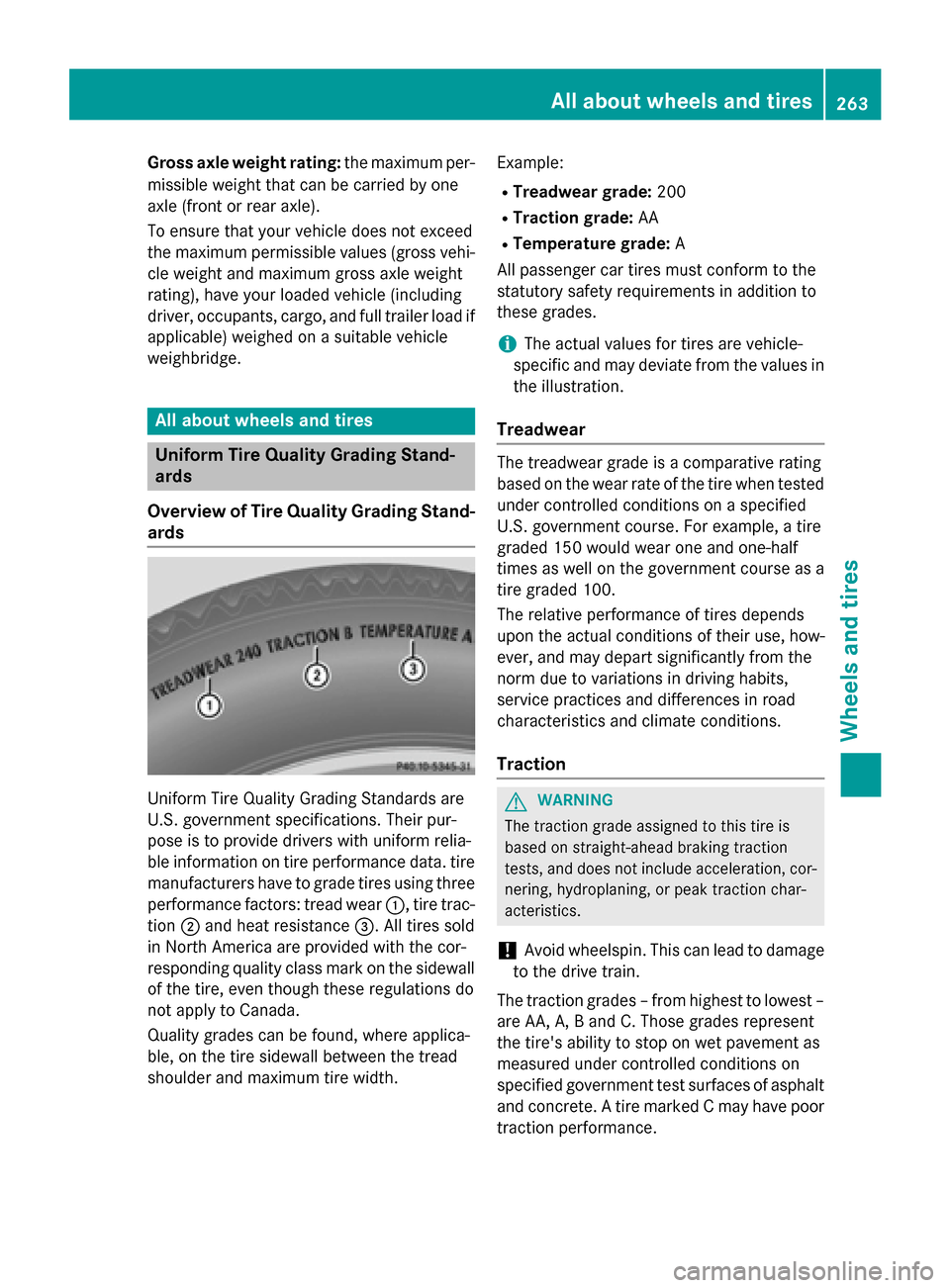
Gross axle weight rating:
the maximumper-
missible weight that can be carried by one
axle (front or rear axle).
To ensure that yourv ehicle does not exceed
the maximu mpermissibl evalues (gross vehi-
cle weight and maximu mgross axle weight
rating), have yourl oaded vehicle (including
driver, occupants, cargo, and full traile rloa dif
applicable) weighed on asuitable vehicle
weighbridge. All about wheels and tires
Uniform Tire Quality Grading Stand-
ards
Overvie wofTire Quality Grading Stand-
ards Uniform Tire Quality Grading Standards are
U.S. government specifications. Theirp ur-
pose is to provid edrivers with uniform relia-
ble information on tire performance data. tire manufacturers have to grade tires using three
performance factors: tread wear 0043,tire trac-
tion 0044and heat resistance 0087.All tires sold
in North America are provided with the cor-
responding quality class mark on the sidewall
of the tire, even though these regulations do
not apply to Canada.
Quality grade scan be found, where applica-
ble, on the tire sidewallb etweenthe tread
shoulder and maximu mtire width. Example:
R Treadwear grade: 200
R Traction grade: AA
R Temperatur egrade: A
All passenger car tires must conform to the
statutory safety requirements in addition to
these grades.
i The actual values for tires are vehicle-
specifi cand may deviate from the values in
the illustration.
Treadwear The treadwear grade is
acomparative rating
basedont he wearrate of the tire when tested
under controlled conditions on aspecified
U.S. government course. For example, atire
grade d150 would wearo ne and one-half
times as wellont he government course as a
tire grade d100.
The relative performance of tires depends
upont he actual conditions of their use, how-
ever, and may depart significantly from the
norm due to variations in driving habits,
service practices and differences in road
characteristics and climate conditions.
Traction G
WARNING
The traction grade assigned to this tire is
basedons traight-ahead braking traction
tests, and does not includ eacceleration, cor-
nering, hydroplaning, or peakt raction char-
acteristics.
! Avoid wheelspin. This can leadtod
amage
to the drive train.
The traction grade s–from highest to lowest –
are AA, A, Band C. Those grade srepresent
the tire's ability to stop on wet pavement as
measured under controlled conditions on
specified government test surfaces of asphalt
and concrete. Atire marked Cmay have poor
traction performance. Alla
bout wheels and tires
263Wheelsand tires Z
Page 269 of 290
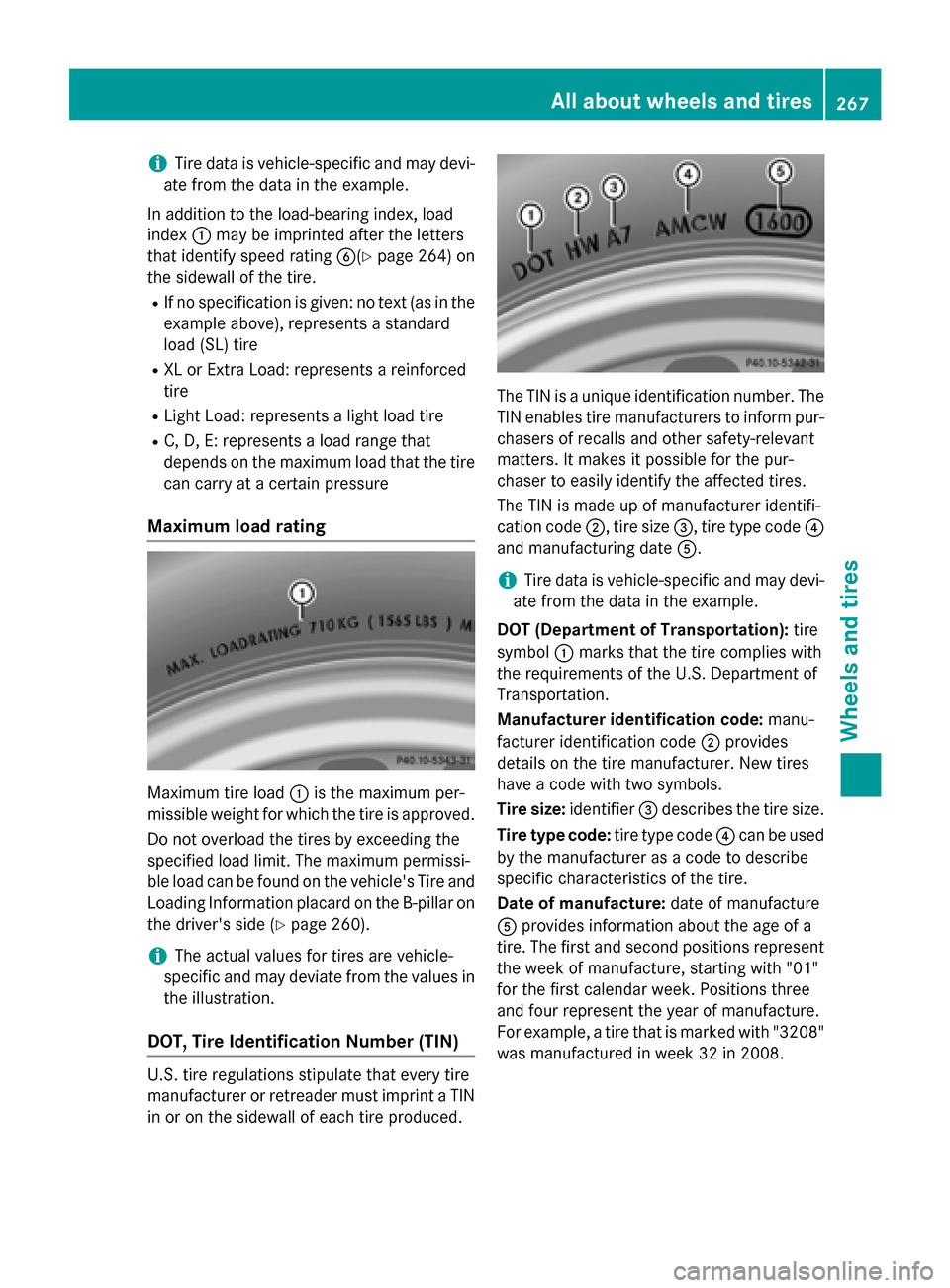
i
Tire data is vehicle-specific and may devi-
ate from the data in the example.
In addition to the load-bearing index, load
index 0043may be imprinted after the letters
that identify speed rating 0084(Ypage 264) on
the sidewall of the tire.
R If no specification is given: no text (as in the
example above), represent sastandard
load (SL) tire
R XL or Extra Load: represent sareinforced
tire
R Light Load: represent salight load tire
R C, D, E: represent saload range that
depends on the maximum load that the tire can carry at acertain pressure
Maximum load rating Maximum tire load
0043is the maximum per-
missible weight for which the tire is approved.
Do not overload the tires by exceedin gthe
specified load limit. The maximum permissi-
ble load can be found on the vehicle's Tire and Loading Information placard on the B-pillar onthe driver's side (Y page 260).
i The actual values for tires are vehicle-
specific and may deviate from the values in
the illustration.
DOT, Tire Identification Number (TIN) U.S.t
ire regulations stipulate that every tire
manufacturer or retreader must imprint aTIN
in or on the sidewall of each tire produced. The TIN is
aunique identification number. The
TIN enables tire manufacturers to inform pur-
chasers of recalls and other safety-relevant
matters. It makes it possible for the pur-
chaser to easily identify the affected tires.
The TIN is made up of manufacturer identifi-
cation code 0044,tire size 0087,tire type code 0085
and manufacturing date 0083.
i Tire data is vehicle-specific and may devi-
ate from the data in the example.
DOT (Department of Transportation): tire
symbol 0043marks that the tire complies with
the requirement softhe U.S.D epartment of
Transportation.
Manufacturer identification code: manu-
facturer identification code 0044provides
details on the tire manufacturer. New tires
have acode with two symbols.
Tire size: identifier0087describes the tire size.
Tire typec ode:tire type code 0085can be used
by the manufacturer as acode to describe
specific characteristics of the tire.
Date of manufacture: date of manufacture
0083 provides information about the age of a
tire. The first and second positions represent the week of manufacture, starting with "01"
for the first calendar week. Positions three
and four represent the year of manufacture.
For example, atire that is marked with "3208"
was manufactured in week 32 in 2008. All about wheelsa
nd tires
267Wheels and tires Z
Page 270 of 290
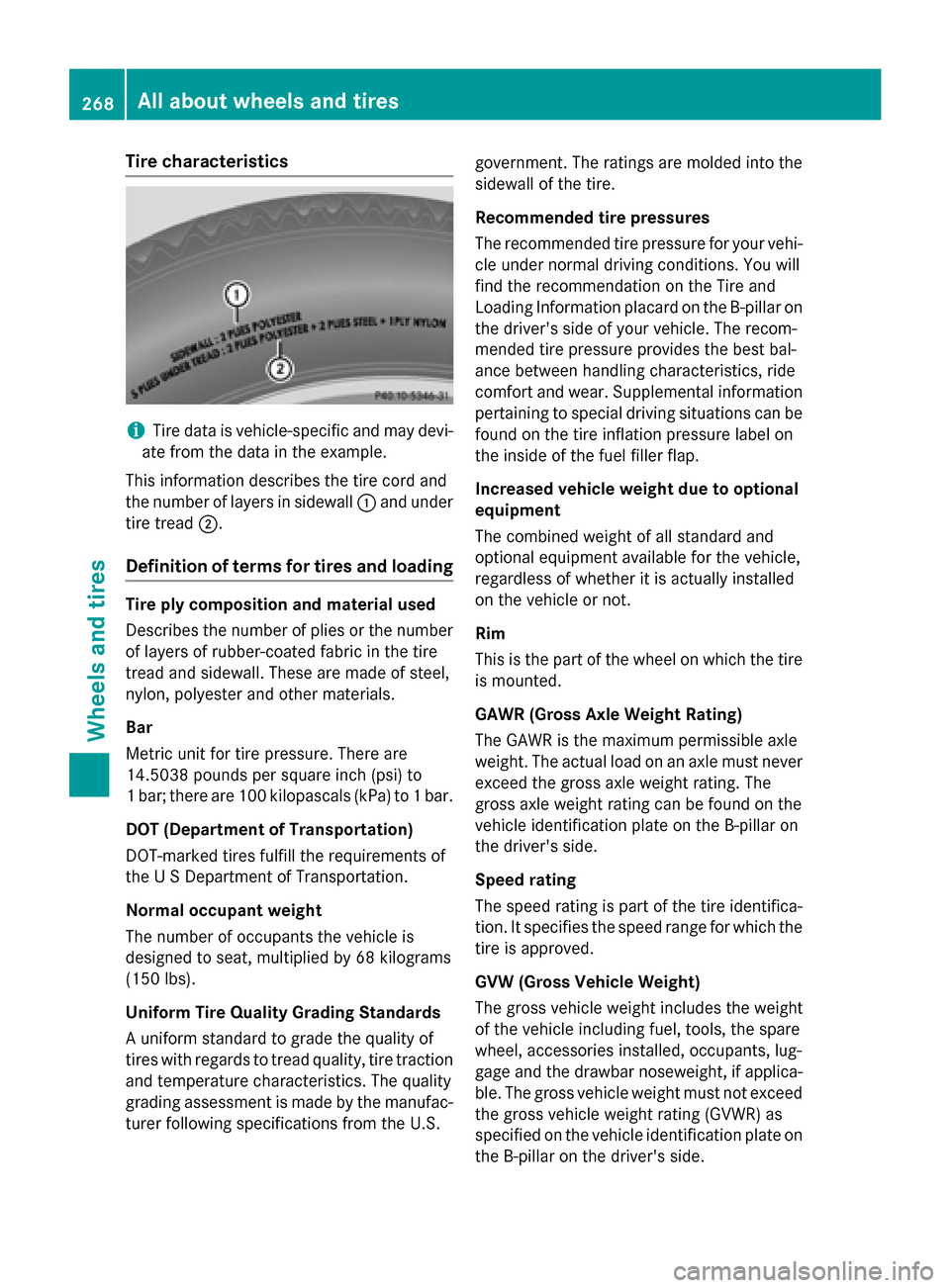
Tire characteristics
i
Tire data is vehicle-specific and ma
ydevi-
ate fro mthe data in the example.
Thi sinformatio ndescribe sthe tire cord and
the numbe roflayer sins idewall 0043and under
tire tread 0044.
Definition of terms fo rtire sa nd loading Tire ply composition and material used
Describes the numbe rofpliesor the number
of layers of rubber-coate dfabricint he tire
trea dand sidewall .These ar emadeofs teel,
nylon, polyeste rand othe rmaterials.
Bar
Metric uni tfor tire pressure. There are
14.503 8pound sp ersquare inch (psi )to
1b ar;ther eare100 kilopascal s(kPa) to 1bar.
DO T(De partmen tofTransportation)
DOT-marked tire sfulfill the requirements of
the USD epartment of Transportation.
Normal occupant weight
The numbe rofoccupants the vehicl eis
designe dtoseat, multiplied b y68k ilograms
(15 0lbs).
Uniform Tire Quality Grading Standards
Au nifor mstandard to grade the quality of
tire swithr egards to trea dquali ty,tire traction
and temperatur echaracteristics. The quality
grading assessment is made by the manufac-
turer following specifications fro mthe U.S. government. The rating
saremolde dinto the
sidewall of the tire.
Recommende dtire pressures
The recommende dtire pressure for your vehi-
cle under normal driving conditions. Yo uwill
find the recommendatio nonthe Tire and
Loading Informatio nplacard on the B-pillar on
the driver's side of your vehicle. The recom-
mended tire pressure provides the best bal-
ance between handling characteristics, ride
comfort and wear .Supplemental information
pertaining to special driving situations can be
found on the tire inflation pressure labe lon
the insid eofthe fuel fille rflap.
Increase dvehicle weight due to optional
equipment
The combine dweigh tofa llstandard and
optional equipment availabl efor the vehicle,
regardles sofwhether it is actually installed
on the vehicl eornot.
Rim
Thi sist he part of the whee lonwhich the tire
is mounted.
GAWR (Gros sAxleW eight Rating)
The GAW Risthe maximum permissibl eaxle
weight. The actual load on an axl emustn ever
exceed the gross axl eweigh trating .The
gross axl eweigh trating can be found on the
vehicl eide ntification plate on the B-pillar on
the driver's side.
Speed rating
The spee drating is part of the tire identifica-
tion. It specifie sthe spee drange for which the
tire is approved.
GVW (Gros sVehicle Weight)
The gross vehicl eweigh tincludes the weight
of the vehicl eincluding fuel ,tools, the spare
wheel, accessorie sinstalled, occupants, lug-
gage and the drawbar noseweight, if applica-
ble. The gross vehicl eweigh tmustn ot exceed
the gross vehicl eweigh trating (GVWR )as
specifie donthe vehicl eide ntification plate on
the B-pillar on the driver's side. 268
Al
la bout wheels an dtiresWheel sand tires
Page 271 of 290
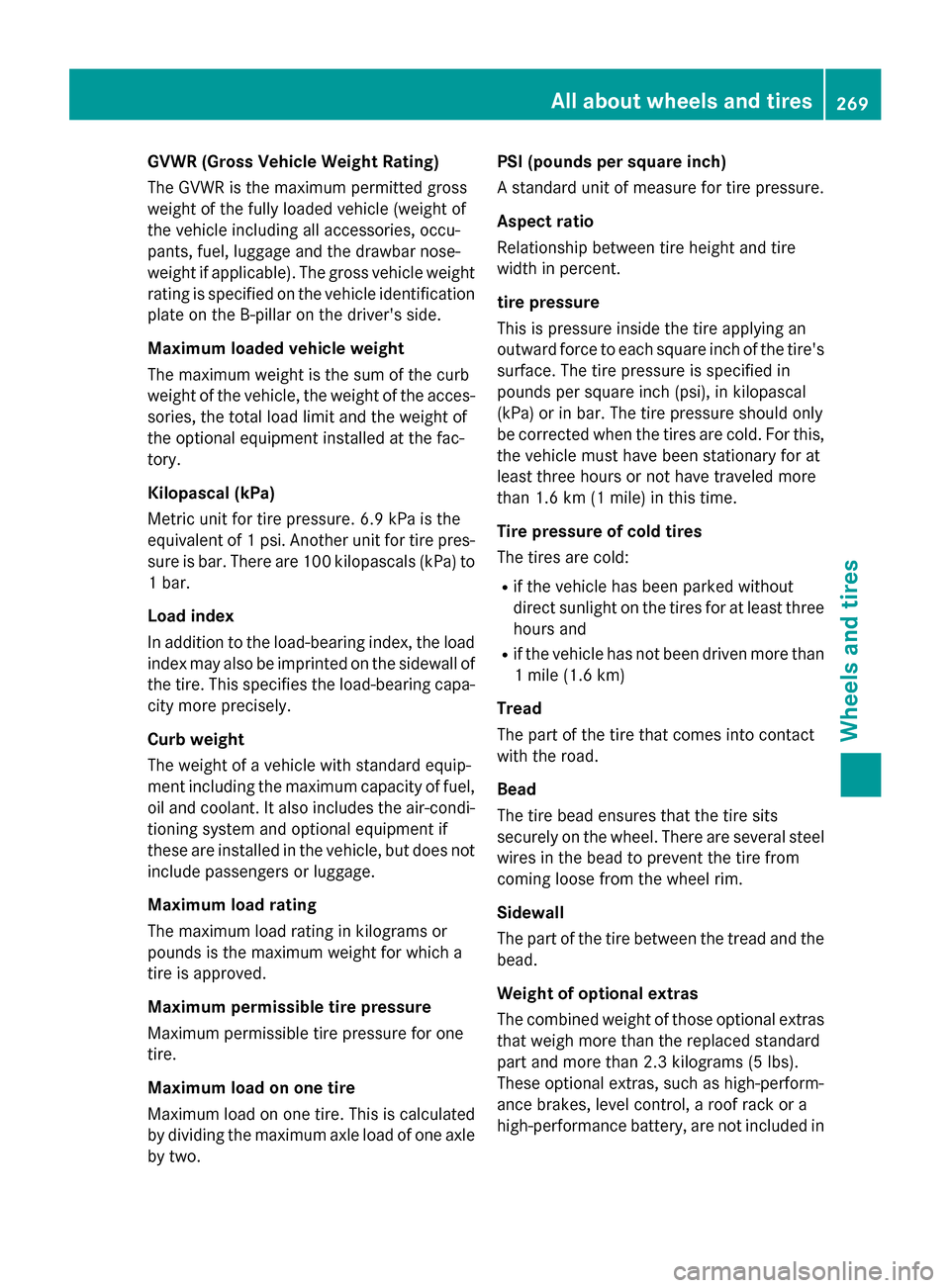
GVWR (Gross Vehicl
eWeight Rating)
The GVWR is the maximu mpermitted gross
weight of the fullyl oaded vehicle (weight of
the vehicle including all accessories, occu-
pants, fuel,l uggage and the drawbar nose-
weight if applicable).T he gross vehicle weight
rating is specified on the vehicle identification plate on the B-pilla ronthe driver's side.
Maximum loaded vehicle weight
The maximu mweight is the sum of the curb
weight of the vehicle ,the weight of the acces-
sories ,the total loadl imitand the weight of
the optional equipment installed at the fac-
tory.
Kilopascal (kPa)
Metric unit for tire pressure. 6.9 kPa is the
equivalent of 1psi.A nother unit for tire pres-
sure is bar. There are 100 kilopascals (kPa) to
1b ar.
Load index
In addition to the load-bearing index, the load index may alsobei mprinted on the sidewallof
the tire. This specifies the load-bearing capa-
city more precisely.
Curb weight
The weight of avehicle with standard equip-
ment including the maximu mcapacity of fuel,
oil and coolant. It alsoi ncludes the air-condi-
tioning system and optional equipment if
these are installed in the vehicle ,but does not
includ epassengers or luggage.
Maximum load rating
The maximu mloadr ating in kilograms or
pounds is the maximu mweight for which a
tire is approved.
Maximum permissible tire pressure
Maximu mpermissibl etire pressure for one
tire.
Maximum load on one tire
Maximu mloadono ne tire. This is calculated
by dividing the maximu maxle loadofo ne axle
by two. PSI (pounds per square inch)
As
tandard unit of measure for tire pressure.
Aspec tratio
Relationshi pbetwee ntire heigh tand tire
width in percent.
tire pressure
This is pressure inside the tire applying an
outward force to each square inch of the tire's surface. The tire pressure is specified in
pounds per square inch (psi), in kilopascal
(kPa) or in bar. The tire pressure shoul donly
be corrected when the tires are cold. For this,
the vehicle must have been stationary for at
least three hours or not have traveled more
than 1.6 km (1 mile)int his time.
Tire pressure of coldt ires
The tires are cold:
R if the vehicle has been parked without
direct sunlight on the tires for at least three
hours and
R if the vehicle has not been driven more than
1m ile (1.6 km)
Tread
The part of the tire that comes into contact
with the road.
Bead
The tire beade nsures that the tire sits
securel yonthe wheel. There are severa lsteel
wiresint he beadtop revent the tire from
coming loose from the wheelr im.
Sidewall
The part of the tire betwee nthe tread and the
bead.
Weight of optional extras
The combined weight of those optional extras
that weigh more than the replaced standard
part and more than 2.3 kilograms (5 lbs).
These optional extras, such as high-perform-
ance brakes, level control, aroof rack or a
high-performance battery, are not included in Alla
bout wheels and tires
269Wheelsand tires Z
Page 272 of 290
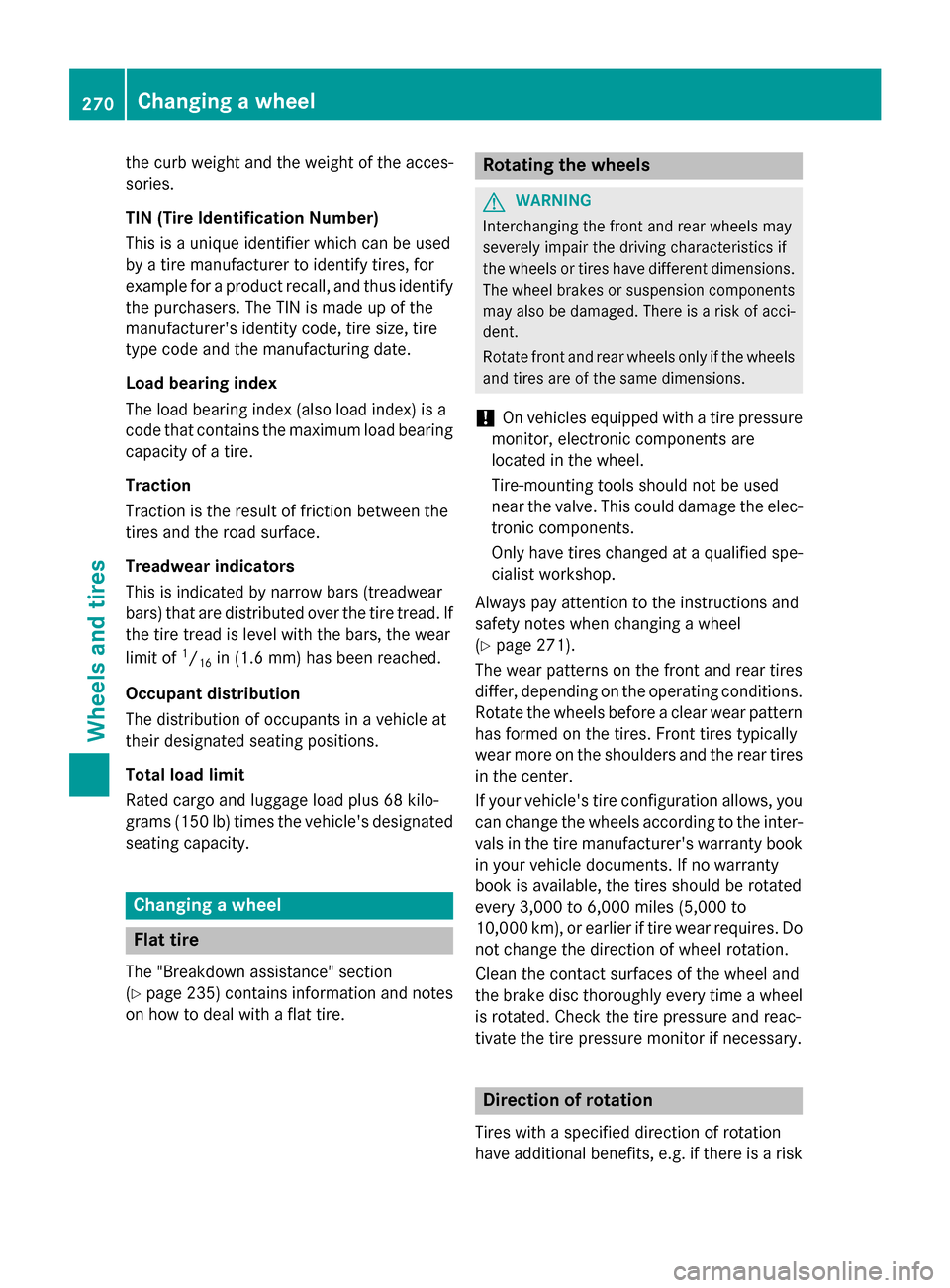
the curb weight and the weight of the acces-
sories.
TIN (Tire Identificatio nNumber)
This is auniqu eide ntifier which can be used
by atirem anufacturer to identify tires ,for
exampl efor ap roduct recall, and thu side ntify
the purchasers. Th eTIN is made up of the
manufacturer's identity code, tir esize, tire
typ ecodea nd the manufacturing date.
Load bearin gind ex
Th eloa db eari ng index (als oloa dindex) is a
cod etha tcontains the maximum load bearing
capacity of atire.
Traction
Tractio nist he resul toffrictio nbetween the
tires and the roa dsurface.
Treadwea rind icators
This is indicated by narrow bars (treadwear
bars) tha tare distributed ove rthe tir etread. If
the tir etrea disl evel with the bars, the wear
limi tof 1
/ 16 in (1.
6mm) ha sbeenr eached.
Occupant distribution
Th ed istributio nofoccupants in avehicl eat
their designated seating positions.
Tota lloa dl im it
Rated cargo and luggag eloa dp lus68k ilo-
grams (15 0lb) times the vehicle' sdesig nated
seating capacity. Changin
gawheel Flat tire
Th e" Breakdown assistance" section
(Y page 235 )contains information and notes
on ho wtod ealw ithaf latt ire. Rotatin
gthe wheels G
WARNING
Interchanging the front and rea rwheel smay
severel yimpair the driving characteristics if
the wheels or tires have different dimensions. Th ew heel brakes or suspensio ncomponents
ma yalsobed amaged .The re is ariskofa cci-
dent.
Rotate front and rea rwheel sonlyift he wheels
and tires ar eofthe same dimensions.
! On vehicles equipped with
atirep ressure
monitor, electroni ccomponents are
locate dinthe wheel.
Tire-mounting tools shoul dnot be used
nea rthe valve. This could damage the elec-
troni ccomponents.
Onl yhavet ires change dataqualified spe-
cialist workshop.
Alway spayattentio ntothe instructions and
safety note swhenc hanging awheel
( Y page 271).
Th ew earp atterns on the front and rea rtires
differ, depending on the operating conditions.
Rotate the wheels befor eaclear wear pattern
ha sformed on the tires .Front tires typically
wear mor eonthe shoulders and the rea rtires
in the center.
If your vehicle' stirec onfiguration allows ,you
can change the wheels according to the inter-
vals in the tir emanufacturer's warranty book
in your vehicl edocum ents.Ifnow arranty
book is available, the tires shoul dberotated
every 3,000 to 6,000 mile s(5,000 to
10,000 km), or earlie riftirew earrequires .Do
not change the directio nofwheelrotation.
Clea nthe contact surfaces of the whee land
the brake disc thoroughly every tim eawheel
is rotated .Check the tir epressure and reac-
tivate the tir epressure monitor if necessary. Directio
nofrotation
Tires with aspecified directio nofrotation
have additional benefits, e.g .ifthere is arisk 270
Changin
gawheelWheels an dtires
Page 288 of 290
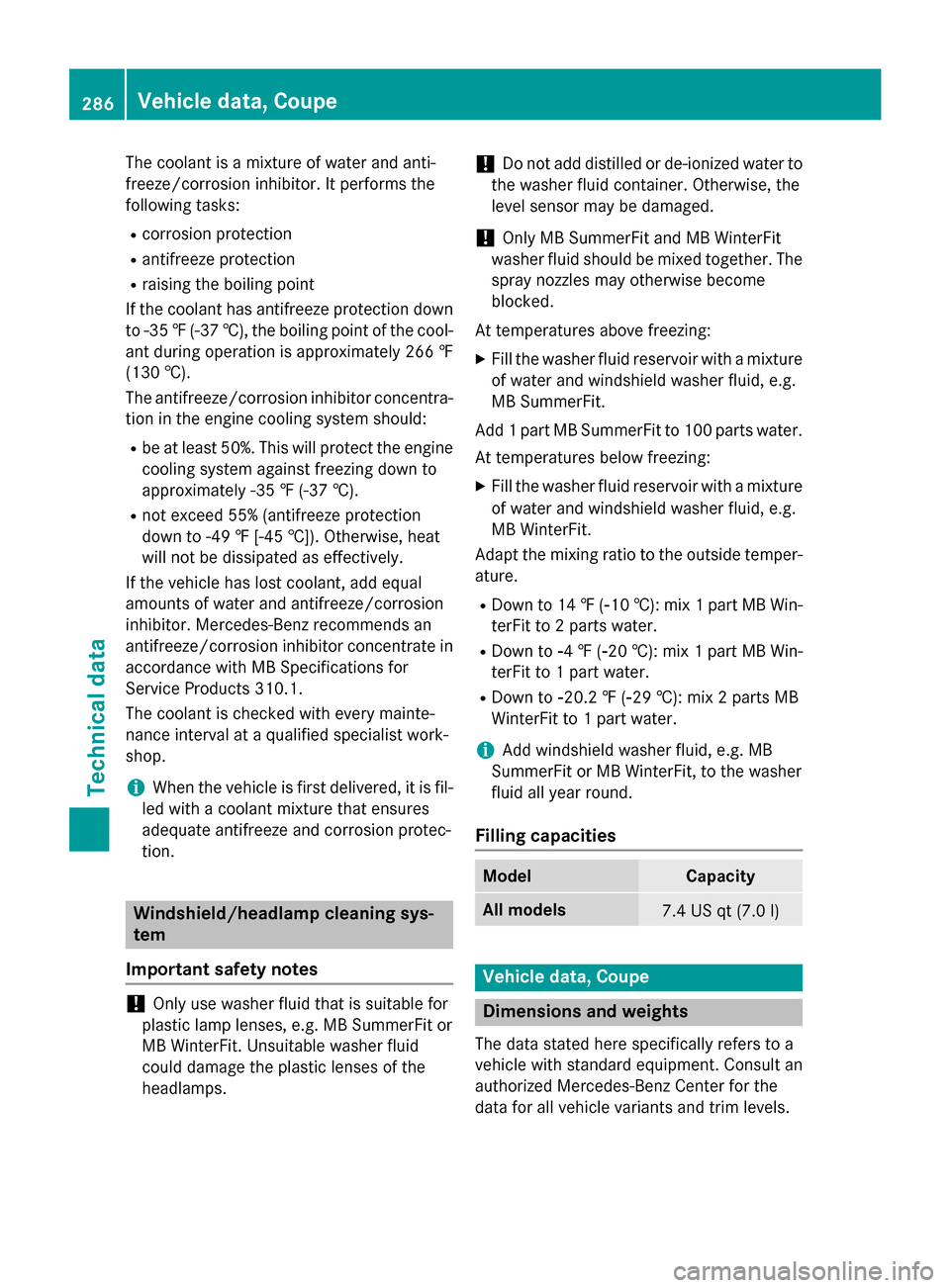
The coolant is
amixture of water and anti-
freeze/corrosion inhibitor. It performs the
following tasks:
R corrosion protection
R antifreeze protection
R raising the boiling point
If the coolant has antifreeze protection down to -35 ‡(-37 †), the boiling point of the cool-
ant during operatio nisa pproximately 266 ‡
(13 0† ).
Th ea ntifreeze/corrosion inhibito rconcentra-
tio nint he engine cooling syste mshould:
R be at leas t50% .Thisw illp rotect the engine
cooling syste magain st freezing down to
approximately -35‡(-37† ).
R no te xceed 55% (antifreeze protection
down to -49‡[-45† ]).O therwise, heat
will no tbed issipated as effectively.
If the vehicl ehaslost coolant, ad dequal
amounts of water and antifreeze/corrosion
inhibitor. Mercedes-Benz recommend san
antifreeze/corrosio ninhibito rconcentrate in
accordanc ewithMBS pecifications for
Service Products 310.1.
Th ec oolant is checked with every mainte-
nanc einterva lataq ualified specialis twork-
shop.
i When the vehicl
eisfirst delivered ,itisfil-
le dw ithac oolant mixtur ethate nsures
adequate antifreeze and corrosio nprotec-
tion. Windshield/headlamp cleaning sys-
tem
Important safety notes !
Onl
yusewashe rfluid thatiss uitabl efor
plastic lamp lenses, e.g .MBSummerFit or
MB WinterFit. Unsuitabl ewashe rfluid
could damage the plastic lense softhe
headlamps. !
Do not ad
ddistilled or de-ionize dwater to
the washe rfluid container. Otherwise, the
level senso rmaybe damaged.
! Onl
yMBS ummerFit and MB WinterFit
washe rfluid shoul dbem ixed together. The
spra ynozzles ma yotherwis ebecome
blocked.
At temperatures above freezing: X Fil lthe washe rfluid reservoi rwitham ixture
of water and windshiel dwashe rfluid, e.g.
MB SummerFit.
Add 1partMBS ummerFit to 100 parts water.
At temperatures belo wfreezing:
X Fil lthe washe rfluid reservoi rwitham ixture
of water and windshiel dwashe rfluid, e.g.
MB WinterFit.
Adapt the mixing ratio to the outside temper-
ature.
R Dow nto1 4‡( 00F810 †): mix 1partMBW in-
terFit to 2parts water.
R Down to 00F84‡(00F820 †): mix 1partMBW in-
terFit to 1partw ater.
R Down to 00F820.2‡(00F829 †): mix 2parts MB
WinterFi tto1partw ater.
i Add windshield washer fluid, e.g. MB
SummerFi torMBWinterFit, to the washer
fluid ally earround.
Filling capacities Model Capacity
Allm
odels 7.4 US qt (7.0
l) Vehicl
edata, Coupe Dimension
sand weights
The data stated her especifically refers to a
vehicl ewiths tandard equipment. Consult an
authorize dMercedes-Benz Center for the
data for al lvehicl evariants and trim levels. 286
Vehicl
edata, CoupeTechnica ldata
Page 289 of 290
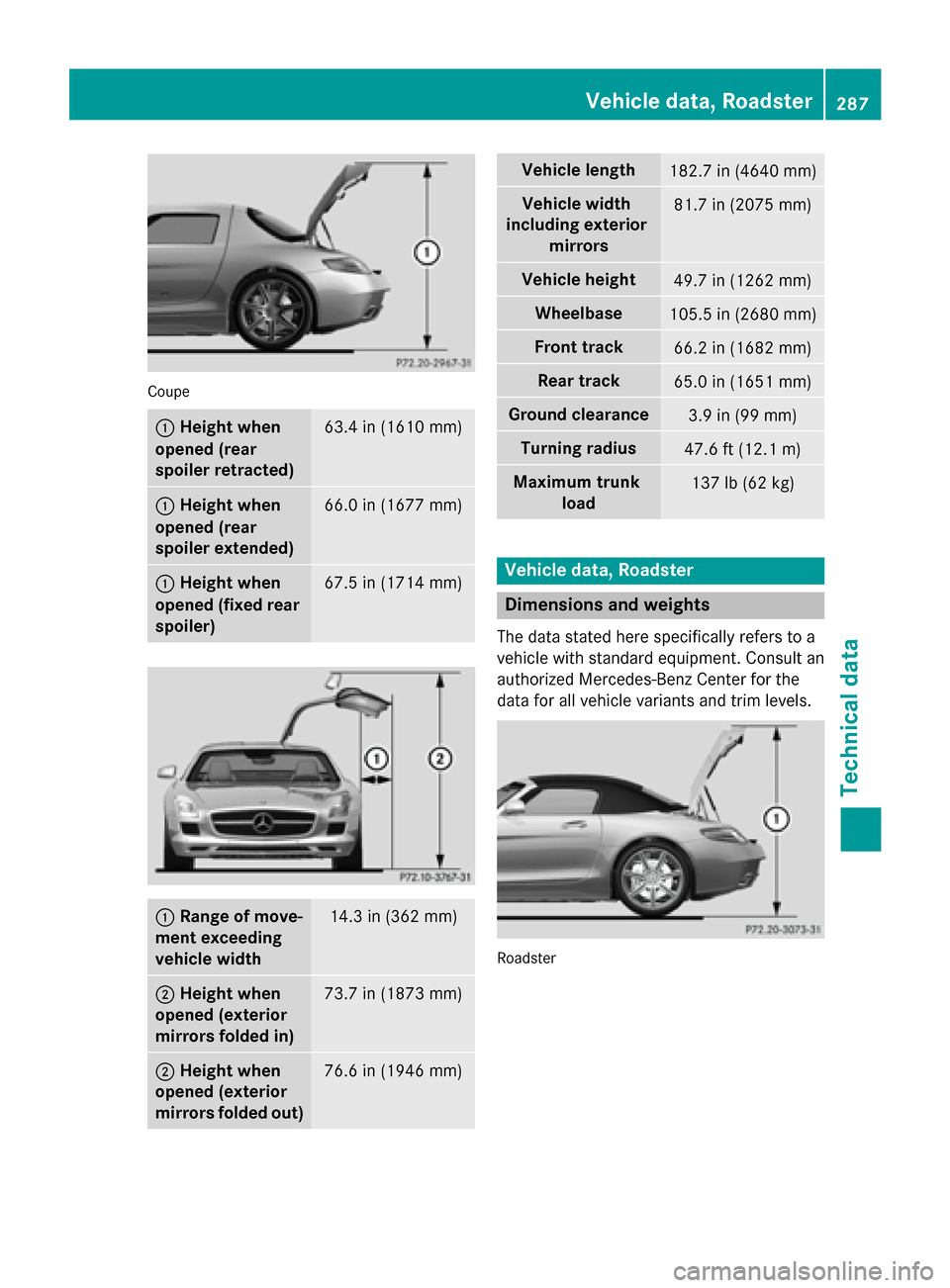
Coupe
0043
Heigh twhen
opene d(rear
spoiler retracted) 63.4 in (1610 mm)
0043
Height when
opene d(rear
spoiler extended) 66.0 in (1677 mm)
0043
Height when
opene d(fixed rear
spoiler) 67.5 in (1714 mm)
0043
Range of move-
ment exceeding
vehicle width 14.3 in (362 mm)
0044
Height when
opene d(exterior
mirrors folde din) 73.7 in (1873 mm)
0044
Height when
opene d(exterior
mirrors folde dout) 76.6 in (1946 mm) Vehicle length
182.7 in (4640 mm)
Vehicle width
including exterior mirrors 81.7 in (2075 mm)
Vehicle height
49.7 in (1262 mm)
Wheelbase
105.5 in (2680 mm)
Front track
66.2 in (1682 mm)
Rear track
65.0 in (1651 mm)
Ground clearance
3.9 in (99 mm)
Turning radius
47.6 ft (12.1 m)
Maximum trunk
load 137 lb (62 kg)
Vehicle data, Roadster
Dimensions and weights
The data stated here specificallyr efers to a
vehicl ewith standard equipment. Consult an
authorized Mercedes-Benz Center for the
data for all vehicl evariants and trim levels. Roadster Vehicle data, Roadster
287Technical data Z